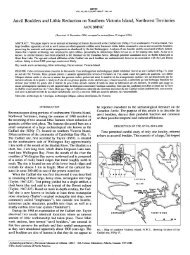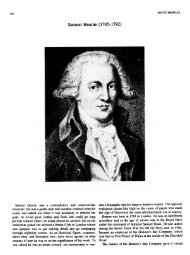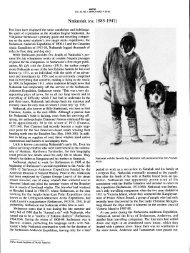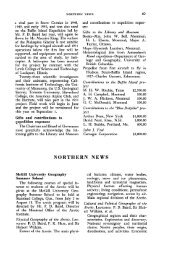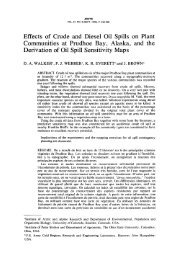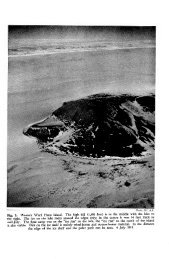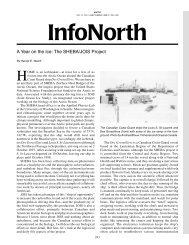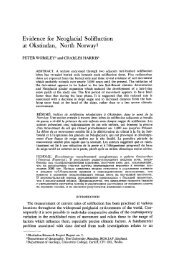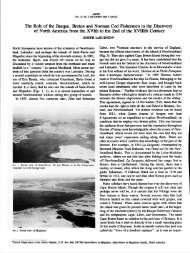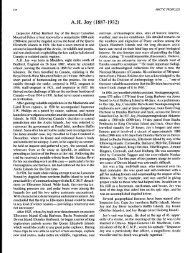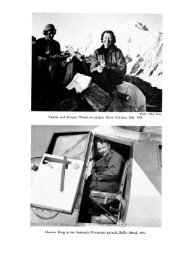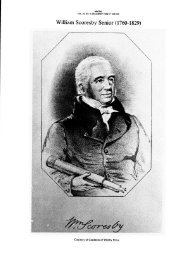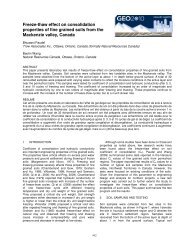NOTES ON THE NUNAMIUT ESKIMO AND MAMMALS OF ... - arctic
NOTES ON THE NUNAMIUT ESKIMO AND MAMMALS OF ... - arctic
NOTES ON THE NUNAMIUT ESKIMO AND MAMMALS OF ... - arctic
You also want an ePaper? Increase the reach of your titles
YUMPU automatically turns print PDFs into web optimized ePapers that Google loves.
164 <strong>THE</strong> <strong>NUNAMIUT</strong> <strong>ESKIMO</strong> <strong>AND</strong> <strong>MAMMALS</strong> <strong>OF</strong> <strong>THE</strong> ANAKTUVUK PASS REGI<strong>ON</strong><br />
found .44 rim-fire shells, along with fragments of caribou bones, a few inches<br />
beneath the surface of the ground, in old campsites. Several calibres next<br />
appeared, including .45-70, .38-70, and .38-55. The latter is said<br />
first obtained in 1908 at Nikilik from the people of Barrow.<br />
to have been<br />
The most popular gun today is the Winchester model 94 in .30-30 calibre.<br />
Also used are the .25-35 and the .25-20. A few men have recently obtained<br />
guns of .257 calibre, which allow much greater success in wolf hunting because<br />
of the longer range. The Nunamiut shoot well, and do not hesitate to kill<br />
large grizzlies with rifles of small calibre.<br />
Hunting methods will be discussed more specifically in<br />
the various species of mammals considered below.<br />
connection with<br />
111. BROOKS RANGE MAhlh’lALS<br />
The observations made so far on the mammals are presented here by<br />
species, according to systematic order. Nunamiut species-names and any<br />
others considered appropriate are included. All prepared mammalogical<br />
material has been deposited in the collections of the U.S. National A4useum<br />
and the National Museum of Canada.<br />
Sorex obscurus obscurus Merriam.<br />
Duskv shrew.<br />
Ugruknak (“like bearded seal”).<br />
About 50 specimens were obtained of this shrew, the most common of the<br />
three species collected in the Brooks Range. Of these, 14 skins with skulls<br />
were deposited in the US. National Museum in 1950; another series of similar<br />
size has been prepared since that time, and the remainder was autopsied for<br />
parasites only. Sorex obscurus seemed particularly abundant around the springs<br />
at Tulugak Lake. Here it was trapped at small burrows in the mosses<br />
Phitonotis fontana and Pohlia Wahlenbergii along the water’s edge. It was<br />
also obtained in vole sets on higherlground in the same area. Specimens of this<br />
shrew were collected in the main valley, but not above an altitude of 2,100<br />
feet; however 9 were trapped in spruce timber in the Savioyok valley at an<br />
altitude of about 2,500 feet, and 4 were taken on upper Hunt Fork.<br />
Few observations were made on the breeding of this animal. In 1949 a<br />
female containing two embryos was collected on June 1, and one containing<br />
nine embryos on July 26; a lactating female was taken on July 12.<br />
The molt into winter pelage occurs during September in this region and<br />
September specimens show much variation in the molt pattern.<br />
Tracks of shrews are often seen in the winter around wolf-kills and other<br />
carcasses, but it was not determined if all species of shrews feed in this manner.<br />
Sorex cinereus ?ugyunak Anderson and Rand.<br />
shrew.<br />
Ugruknak. Arctic cinereous<br />
On the basis of the first material collected, the cinereous shrew of the<br />
Tulugak Lake region and of Umiat was assigned to this form. Anderson and<br />
Rand (1945) also assigned two specimens from the eastern Brooks Range to<br />
the subspecies ugyunak. After adequate series arc obtained, and when com-



